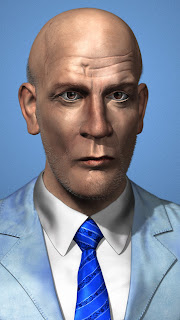This past week was spent doing more technical things to get ready to texture the model. I started off by reusing the brass and chrome shaders
from my robot, as well as the HDRI image I used for lighting. Right now there is a lot to be done with textures and I have to be clever in how I go about doing it.
I added some glow in Photoshop after the fact, just for kicks.
The biggest challenge this week was working with lights and mental ray shaders in Maya. What you see in the following renderings are just raw shaders with no texture maps applied. I did do some effects with some procedural texture nodes from Maya, but the rest are just the shaders. They are going in the direction that I want, but I have a long ways to go before I feel like they are finished.
I used the Mental Ray architectural shaders for pretty much everything in the interior since it is supposed to be shiny and new. They don't have a separate specular channel and everything is reliant on reflective properties.
Each of these frames took around 25 minutes to render with medium settings. I will need to increase the number of samples for each shader which will increase render times when I go to do the final versions.
Just as a side note, the velvet for the couches was something I had to think creatively about, and I'm not quite sure that it is there yet. I plugged a Ramp shader into the diffuse channel of the shader and attached a sampler node to the shader. Essentially, what is does is samples the normals of the model of the couch. Anything that is facing the camera gets a certain color applied to it while the rest changes color as it gets farther away. It needs work, but it is a good way to fake the specular highlight that hits at the edge of something with tiny fibers on it.
I used Final Gather with these renderings, which smooths out the lighting in your scene quite a bit. It helps illuminate the darker areas that aren't directly hit by light. Also, geometry with ambient materials applied to them give off "light" that illuminates the surrounding surfaces. It's fairly good for faking real world light bounces.
I have a lot of texture work to do and because I don't know when I am presenting, I have to pretend that I only have a month to complete it all. Some surfaces will only require a bump map, and the shading will be able to do the rest. Others might require bump and color. Still others might require some fancy work with the reflection.





































